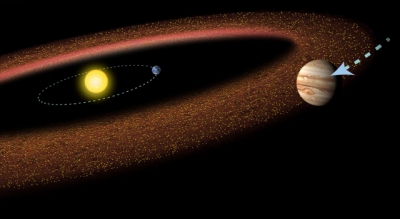
Scattered in orbits around the sun are bits and pieces of rock left over from the dawn of the solar system. Most of these objects, called planetoids or asteroids — meaning “star-like” — orbit between Mars and Jupiter in a grouping known as the Main Asteroid Belt.
The Main Asteroid Belt lies more than two-and-a-half times as far as Earth does from the sun. It contains millions of asteroids, according to NASA. Most of these are relatively small, from the size of boulders to a few thousand feet in diameter. But some are significantly larger.
The Main Belt lies between Mars and Jupiter, roughly two to four times the Earth-sun distance, and spans a region about 140 million miles across. Objects in the belt are divided into eight subgroups named after the main asteroids in each group. These groups are the Hungarias, Floras, Phocaea, Koronis, Eos, Themis, Cybeles and Hildas.
Although Hollywood often displays ships making close calls through asteroid belts, the trip is generally uneventful. A number of spacecraft have safely traveled through the asteroid belt without incident, including NASA’s New Horizons mission to Pluto.
“Fortunately, the asteroid belt is so huge that, despite its large population of small bodies, the chance of running into one is almost vanishingly small — far less than one in a billion,” wrote New Horizons principle investigator Alan Stern. “If you want to come close enough to an asteroid to make detailed studies of it, you have to aim for one.”
Within in the asteroid belt are relatively empty regions known as Kirkwood gaps. These gaps correspond to orbital resonances with Jupiter. The gas giant’s gravitational pull keeps these regions far emptier than the rest of the belt. In other resonances, the asteroids can be more concentrated.
Credit : Space.com
Picture Credit : Google




